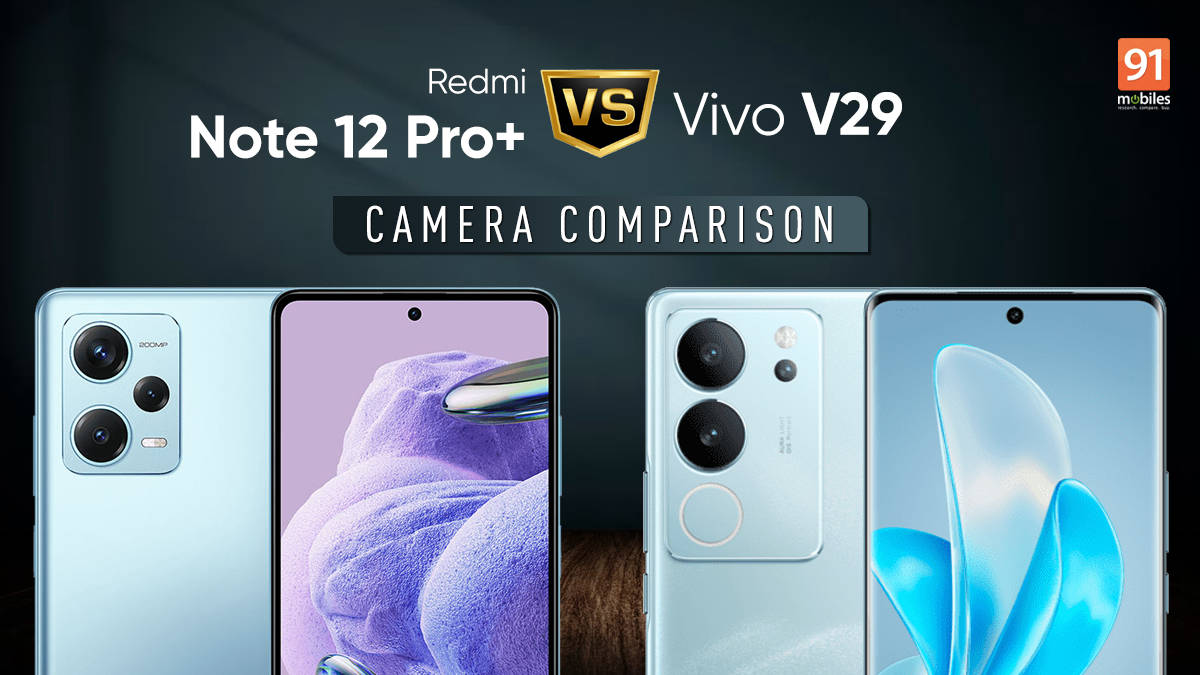
If you’re looking for a relatively affordable camera-focused smartphone, chances are that the Redmi Note 12 Pro+ (review) might catch your attention. That’s because the Redmi phone (starts at Rs 27,999) boasts a stylish build and a 200MP primary camera, which may seem unheard of in this segment. But if you spend Rs 5,000 extra, you can choose the Vivo V29 (review), which is among the rarest Android smartphones to feature an inbuilt ring light (called Smart Aura). Naturally, this ring light drastically improves low-light photos.
Of course, the price difference is quite wide, but perhaps that’s what one will pay to capture better photos for those crucial Instagram uploads. Let’s compare photos taken by the Redmi Note 12 Pro+ and Vivo V29 to see whether this price difference is justified in the first place.
Table of Contents
Redmi Note 12 Pro+ vs Vivo V29 camera specifications
| Redmi Note 12 Pro+ | Vivo V29 |
| 200MP primary camera | 50MP primary camera with OIS |
| 8MP ultra-wide camera | 8MP ultra-wide camera |
| 2MP macro camera | 2MP depth sensor |
| 16MP selfie camera | 50MP selfie camera |
Daylight


In broad daylight, the Redmi Note 12 Pro+ and Vivo V29 capture good details with their respective primary rear cameras. The two phones also work effectively in capturing details of the red signboard at the back or leaves in the foreground as well.
As the Redmi Note 12 Pro+ boasts a 200MP camera, the details are slightly sharper in some areas, especially near the bush in the background. However, the Vivo V29’s 50MP camera captures adequate light. The Vivo V29 also processes the image nicely with more colours and higher saturation. As a result, its image is more pleasing to look at.
Winner: Vivo V29
Ultra-wide


The Redmi Note 12 Pro+ and Vivo V29 include 8-megapixel ultra-wide cameras with a similar f2.2 aperture. However, the two phones process the scene much differently.
The image shot using the Vivo V29 is similar to that of its primary camera. It means you will notice the same level of detail and boosted colours. The Redmi Note 12 Pro+ somehow captures more sharpness, and the image looks more natural. Both images were captured with ISO 50 (auto), but the Vivo has over-processed the scene, which some of you may like. I prefer the image with the Redmi Note 12 Pro+, but it’s totally fine if you go with Vivo.
Winner: Redmi Note 12 Pro+
Selfie


I like selfies from both phones in broad daylight, even though the Vivo V29 includes a 50MP selfie snapper compared to the Redmi Note 12 Pro+ 16MP camera. The Vivo smartphone detected my skin tone more accurately but, I am equally happy with the Redmi phone’s output.
The competition between the two in this department is neck and neck. But my vote goes to the Vivo V29 for capturing much better facial details, visible once zoomed in.
Winner: Vivo V29
Selfie (HDR)


I wasn’t totally satisfied with the simple selfie camera test as both phones performed efficiently under good lighting conditions. To check the processing capabilities, I took selfies against the light to see the HDR capabilities. The difference, as you can see, is substantially vast.
Not only does the Vivo V29 process the overexposed background better, but facial details are also well maintained. The image by Vivo phone also includes prominent shadows on the green jumper that adds some degree of drama. The Redmi Note 12 Pro+ does not detect the scene well, and the result is flat.
Winner: Vivo V29
Portrait


The Redmi Note 12 Pro+ and Vivo V29 utilise the primary camera sensor for portraits. The Vivo phone also automatically enables the ring light (Smart Aura) with both 1x and 2x zooming. You can even adjust the tone of the Smart Aura light to cool or warm.
At first glance, you will barely notice any difference between the two portrait images. But thanks to the Smart Aura light hitting the face, the Vivo phone captures more facial details (visible once zoomed in). The Vivo V29 does struggle to recognise the accurate shade of my lips, resulting in a strange pinkish hue. The Redmi Note 12 Pro+ keeps the scene as natural as possible, with a rich bokeh effect.
Overall, it’s a close fight, but I am picking Vivo V29 for capturing better facial details.
Winner: Vivo V29
Low light


The Redmi Note 12 Pro+ and Vivo V29 perform more or less similarly in this low-light condition. It’s difficult to pick a winner as both phones have similar strengths and weaknesses, at least in low light. The dynamic range from both phones is also average at best.
The Redmi Note 12 Pro+ offers more sharpness, resulting in more readable signs in the background. The Vivo V29, on the other hand, offers more saturation by default, resulting in a yellowish tint across the image. Therefore, the leaves appear greener, and the light from the street lamp is vibrant.
Winner: Tie
Low light with night mode


Both smartphones struggle with focus and sharpness in extreme low-light conditions, even with night mode enabled. For instance, the Redmi Note 12 Pro+ was able to focus on the action figure with simple point-and-shoot. The Vivo V29 ended up focusing on the plant.
The duo also treats colours differently. The Redmi Note 12 Pro+ captured the red ambient light, while the Vivo V29 turned the red into a pinkish hue. Overall, the image captured by the Vivo V29 offers better details, but neither of them accurately represents the scene.
Winner: Vivo V29
Verdict
The Vivo V29 emerged as the winner in our camera test, winning five out of seven scenes. The Redmi Note 12 Pro+ wasn’t far behind, at least in good lighting conditions, but the Smart Aura ring light definitely provides the Vivo V29 an edge. There are some other things that you should remember. For instance:
- Video performance is better on the Vivo phone. The Vivo V29 offers more stability at 60fps in 1080p. It also filtered ambient noises better than the Redmi Note 12 Pro+.
- I prefer the cleaner interface of the native camera app on the Redmi Note 12 Pro. Additionally, the phone offers a macro mode, which can be hit-and-miss.
- The Smart Aura ring light on the Vivo V29 is also available to use with normal mode. It means you can use the inbuilt ring light instead of flash.


![[Exclusive] itel Unicorn smartwatch that doubles up as a pendant to launch in India soon Thumbnail](https://www.91-cdn.com/hub/wp-content/uploads/2024/05/itel-unicorn-pendant-watch-100x70.jpg)